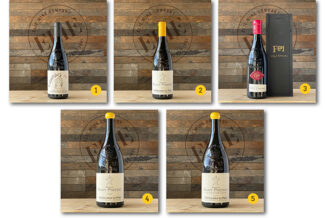Que Será, Syrah in Northern Rhône by Johann Michel in Cornas & Saint-Joseph (4-Bottle Pack $299) + Southern Rhône’s Grenache in Châteauneuf-du-Pape by Grenachiste Isabel Ferrando (4-Bottle Pack, $324)
The faces of Rhône wear many expressions, and no one makes a firmer imprint on the senses than the two dynamic winemakers represented in this week’s North/South Rhône package. Though frequently conflated under an all-encompassing carpet of ‘Rhône wines’, in terms of climate, soil structure, elevation, grape varieties and overall attitude, these two regions couldn’t be more different. Whereas Northern Rhône’s steeply terraced hillsides and granite soils can only produce a handful of varieties (mainly Syrah and Viognier), Southern Rhône—being flatter and subject to milder winters, hotter summers that are often influenced by Mistral winds—is the home of some of the most complex grape blends in winedom.
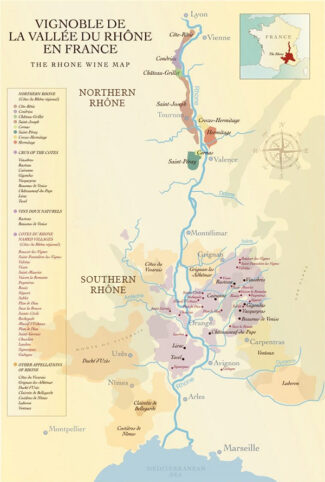
There is no better path to discovering both sides of the coin than sampling two of the most intriguing winemakers in Rhône: Johann Michel in the North and Isabel Ferrando in the South. Both are representative and neither are ‘typical’; both are as iconic as they are iconoclastic. Pick your favorite or love them both equally, as we do.
Northern Rhône Vineyards: Etched into the Mountain
The vineyards of Northern Rhône may be the oldest in France, but one thing is certain: Harvesting them ages the workforce. The terraced hillside sites are so steep that the grapes sometimes have to be lowered by pulley, like on a ski slope. It’s said that, in order to make a commercially viable product on sites with sufficient sunlight to fully ripen grapes, you have either to inherit an established right-bank vineyard or produce a wine so good that you can charge an exorbitant price.
Indeed, the most famous producers of the Northern Rhône are family enterprises; these are wineries that vinify grapes they grow, but also purchase fruit from vineyards along length of the entire Rhône valley. The smallholders are the ones who put the sweat equity into these demanding sites, and traditionally, only a handful of them have bottled under their own labels.
This is beginning to change as ambitious newcomers have entered the foray as grower/producers and, at least among those who have been up to the test, have improved the overall quality of the appellation.
Que Será: Syrah
Why Syrah, Syrah? Just the facts, ma’am: Red wine from Northern Rhône is made nearly entirely from Syrah with an occasional sprinkling of Viognier for spice, and produces these bottles that can age for generations. And it is fair to say that the region sets the global standard on how Syrah is judged.
And that’s because it is terrain ideally suited for such a thick-skinned grape known for its ability to withstand drought-like conditions. It thrives in many warmer viticultural regions, true, but nowhere better than along the steep, sun-soaked terraces of Northern Rhône, where irrigation is all but impossible. Syrah also produces loose bunches of big grapes, meaning that its susceptibility to various mildew diseases is minimal: The Mistral wind, upon which Southern Rhône depends to dry out the damp, is unnecessary here, and that works out fine: By a quirk of geography, the peculiar shape of the Rhône Valley protects the northern vineyards from these strong, cold, northwesterly winds.
Northern Rhône Package $299
We are pleased to offer one bottle of each of the following four wines from Domaine Johann Michel for a package price of $299.
Domaine Johann Michel
A Syrah Master, Naturally
Give a man a bottle and he’ll drink for a day; teach him to make wine and he’ll drink for a lifetime. Still, there is something in the spirit of the man who figures it all out for himself that excites us even more.
Johann Michel developed a passion for fine wine while tasting old vintages with his grandfather, and from there, taught himself the art of vinification. Today, with his wife Emmanuelle, he works 14 acres spread between three Rhône AOP’s. This includes a scant acre in Saint-Joseph planted entirely to Syrah, two-and-a-half acres in the extreme south of Saint-Péray planted to Marsanne and Roussanne, and his most celebrated wines made from lieux-dits in the steep, granite infused slopes of Cornas.
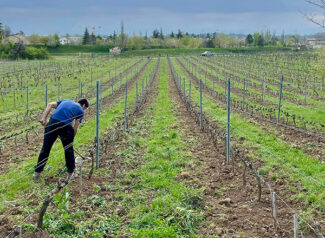
Johann Michel
Michel may be self-taught, but the effusive praise for his product is very much the domain of experts. In what may be the most hyperbolic wine review I’ve ever read, critic Jeb Dunnuck (Northern Rhône: 2019s From Bottle, February 16th 2022) wrote: “The Cornas from Johann Michel is a majestic, full-bodied, incredibly seamless beauty that does everything right, showing the ripe, sunny style of the vintage and bringing ample fruit, richness and power with incredible focus as well as purity and freshness. It will evolve for 15 years or more, and I doubt it will ever close down. Those who like flawlessly balanced Cornas should back up the truck for this sensational wine.”
Cornas: No Country Bumpkin
A truism in the world of viticulture is that grape vines often grow in places where nothing else will. This is certainly the case among those grapes cultivated on slopes so steep as to nearly (but not quite) defy sanity. To find examples of death-defying hillside vineyards, look to the Mosel and Rhine valleys in Germany, Ribeira Sacra in Spain, the Douro in Portugal and Cornas in the Northern Rhône Valley.
One of the smallest appellations in Rhône, Cornas is, in its entirely, under three hundred acres—smaller than some single estates in Bordeaux. It produces only red wines made exclusively from Syrah—a variety that ripens with greater ease here than virtually anywhere else in Northern Rhône.
Celtic for ‘burnt earth’, Cornas wines—in homage to the name or vice versa—frequently reflect smoky notes with deep, burly earth tones. Once considered country wines of value only to those who love rusticity, the reputation of Cornas has skyrocketed in recent vintages to become one of the most sought-after wines in France.
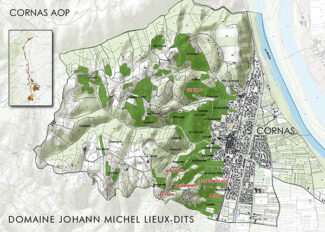
The quality of these wines is the culmination of many factors, but among the most singular is the fact that Cornas sits on a large chunk of granite. Unlike Cote Rôtie to the north, where there is plenty of schist, or Hermitage, where the granite merges into alpine soils, Cornas is almost purely Massif Central granite, giving the wines a pronounced and savory minerality.
To Stem or Not to Stem
When you see ‘whole cluster fermentation’ in a winemaker’s description, he or she is referring to a technique where entire grape bunches, including stems, go into the fermenter. In other words, the wine grapes do not go through a destemmer-crusher to destem individual berries and crush out the juice.
Advocates of whole cluster fermentation assert it produces wines with more complexity, and with additional herbal and spice flavors, toning down high acidity while adding tannic structure. The practice may be seen frequently with Pinot Noir in Burgundy and Oregon’s Willamette Valley, and in Northern Rhône, winemakers claim that it enhances the savory qualities and peppery notes of Syrah. Where grapes are fully ripened, as they tend to be in Cornas, stems bring significant tannin to the party, and so the wine requires intense fruit for balance. But by binding chemically with tartaric acid, stems tend to lower acidity in the process, so a careful balancing act must be maintained. It should be noted that the more mature the stems, brown and woody instead of green, the more subtle the influence.
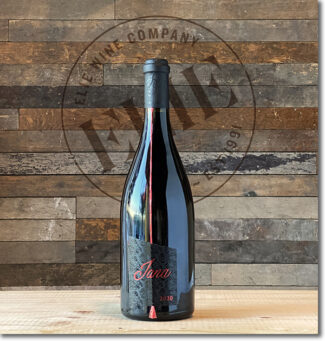 Domaine Johann Michel ‘Cuvée Jana’, 2020 Cornas ($79) (Lieux-dits Chaillot / Bayonnet) (One Bottle)
Domaine Johann Michel ‘Cuvée Jana’, 2020 Cornas ($79) (Lieux-dits Chaillot / Bayonnet) (One Bottle)
Named after Johann and Emmanuelle’s daughter Jana, this blend comes from two of Michel’s favorite lieux-dits: Chaillot, which was planted in 2000 by Johann himself and nearby Bayonnet where soils are made of granitic sand. The wine shows black raspberry, licorice, sizzling bacon and campfire smoke along with integrated tannins and crunchy acidity
*click on image for more info
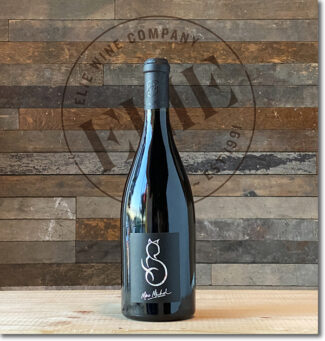 Domaine Johann Michel ‘Cuvée Mère Michel’, 2020 Cornas ($152) (Lieu-dit Les Côtes) (One Bottle)
Domaine Johann Michel ‘Cuvée Mère Michel’, 2020 Cornas ($152) (Lieu-dit Les Côtes) (One Bottle)
‘Mother Michel’ refers to Emmanuelle rather than Johann’s mom; we’ll leave further interpretation to Freudians. The wine was first introduced in 2016 and is not produced every year; it is Selection Massale—the replanting of new vineyards with cuttings from exceptional old vines—in this case, from the 1947 Yves Cuilleron vineyard at Chavanay. Les Côtes is a south-facing lieu-dit sits at an altitude of 900 feet and here produces an intense nose of black fruit, spices and wood smoke. On the palate, the wine is meaty and crisp with bright plum and anise, showing the sweet opulence of Syrah fruit.
*click on image for more info
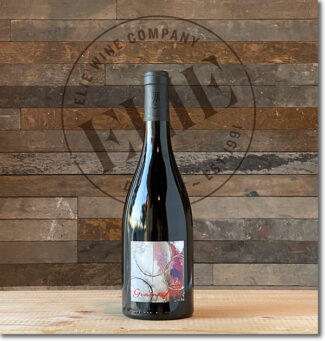 Domaine Johann Michel ‘Grain Noir’, 2020 VdF Northern Rhône Rouge ‘Syrah’ ($29) (Lieu-dit Le Moulin) (One Bottle)
Domaine Johann Michel ‘Grain Noir’, 2020 VdF Northern Rhône Rouge ‘Syrah’ ($29) (Lieu-dit Le Moulin) (One Bottle)
Johann Michel says, “The Grain Noir cuvée is produced in the commune of Cornas but outside the appellation—hence, the VdF designation. The Le Moulin vineyard is located in the north of Cornas, near the Rhône, where sandy soils and pebbles exist at an altitude between three and four hundred feet.”
The wine shows Michel’s characteristic wine power; big structure backed up with ripe, fleshy, vibrant fruitiness and finishing with silky tannins and the bite of minerality.
*click on image for more info
Saint-Joseph: Chile of the Rhône Valley, a Lot of Range
According to Joël Durand of Domaine Eric & Joël Durand, “Saint-Joseph isn’t really a Rhône wine. It’s a collection of crus.”
That describes most Rhône appellations, of course, but Saint-Joseph is unique in that, despite its long, thin size, it remains relatively unknown. Stretching more than 40 miles down the right bank of the river and taking in more than two dozen towns and villages in two departments, the Ardèche and the Loire, its strung-out geography have been likened to Chile. But while South America is known for bold, fruity Syrah, Saint-Joseph produces elegant, tightly focused reds and whites that often have more in common with the wines of Burgundy than their Chilean counterparts.
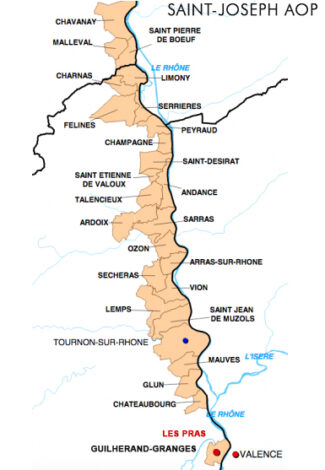
But the diversity is there: The main component in the appellation’s soils is granite, but other minerals may equally impact production. The southern portion is made up of tender gneiss and gives the wines a unique character.
Where there is less diversity is in the varietal selection; for the vast majority of Saint-Joseph’s wines, the reds are exclusively Syrah, representing about 86% of total production, while the whites, making up 14%, are Roussanne and Marsanne—as stand-alones or as a blend.
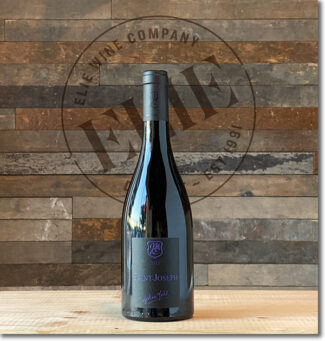 Domaine Johann Michel, 2019 Saint-Joseph ($39) (Lieu-dit Les Pras) (One Bottle)
Domaine Johann Michel, 2019 Saint-Joseph ($39) (Lieu-dit Les Pras) (One Bottle)
Bold ripe black fruits, 100% destemmed grapes and matured in seasoned French oak, the plummy, generously textured wine is marked by delicately smoky, spicy hints of char and crushed peppercorn, then spice, complexity, velvety tannic grip and a powerful finish.
*click on image for more info
Southern Rhône: To Blend or Not to Blend
The magic of the blend is the keystone in Châteauneuf-du-Pape’s rock-solid reputation; fifteen varieties are legally permitted in the appellation, and the proportion of each used in the final cuvée is a reflection of the vineyard’s potential, the estate’s philosophy and the vigneron’s artistry. The palette is juice, the canvas is the élevage and on opening day—and for many years to come—the exhibition wears the familiar embossed insignia of a Châteauneuf-du-Pape bottle.

But is blending always the goal in Châteauneuf-du-Pape? Red wine comprises 95% of Châteauneuf-du-Pape’s output, and most of it is built around the Big Four—Grenache, Syrah, Mourvèdre and more recently, Cinsault. But as a quartet, they are hardly equal: As of 2014, 73% of the vineyards in the appellation were planted to Grenache, with Mourvèdre making up about 7% and Syrah, just under three percent—a number that may soon be supplanted by Cinsault as Syrah continues to lose popularity in the region. Even so, so dominant is Grenache in most blends that a winemaker would likely have to provide a vivisection of varietal profiles to explain how each trace addition affects the final cuvée. The blending spectrum in Châteauneuf-du-Pape, therefore, covers extremes: Château de Beaucastel frequently uses all the allowable grapes in their cuvée while another of Châteauneuf’s most important names, Château Rayas, uses only Grenache.
Grenache: Captures the Sun
Despite its potential for splendor in the glass, Grenache has never made the leap into the rarified atmosphere of the ‘noble’ grapes. But in the right hands, grown in the correct lieu-dit and farmed correctly, it can be as expressive of terroir as Pinot Noir and as complex and age-worthy as Cabernet Sauvignon. In Châteauneuf-du-Pape, it produces most favorably on sandy soils that provide delicacy and finesse, but where there is also limestone for structure, red clay for the development of rich (but not harsh) tannins and the small stones known as ‘galets’ for power.
For a grape that produces such bold and muscular wines, Grenache is thin-skinned and not overly acidic, so it must be picked at an optimum period of phenolic ripeness to avoid becoming flabby and aggressively alcoholic. Vine age is of extreme importance for Grenache, with younger cultivars making pale-colored and often mediocre wines—60 -100 years appears to be an ideal age for producing wine of consistently good quality.
Southern Rhône Package $324
We are pleased to offer one of each of the following four wines from Domaine Saint Préfert for a package price of $324.
Domaine Saint Préfert
The Grenachiste
If a ‘Grenachiste’ is a loyalist who fights for Grenache, it would be hard to find a High Priestess more qualified than Isabel Ferrando. A former banker who learned winemaking at Domaine Raspail-Ay in Gigondas, she purchased the seventy-year old Domaine Saint-Préfert from the Serre family (one of the region’s first domains to estate bottle) in 2003. That year, the property stood at a little over thirty acres, all in the Les Serres lieu-dit south of the village of Châteauneuf.
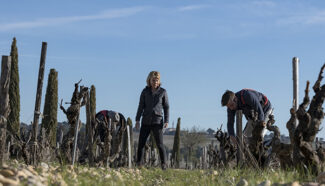
Isabel Ferrando
Once a successful first vintage was in the cellar, Ferrando began to purchase more land in the appellation, expanding her holdings to its current 55 acres. Among her acquisitions was a small parcel of old-vine Grenache vines that became Domaine Ferrando Colombis. Meanwhile, in 2013, Domaine Saint Préfert earned its certification for using 100% biodynamic farming, an agricultural technique that is somewhat easier pull off in Châteauneuf thanks to the sporadic but predictable Mistral winds that naturally protect vines from pests and mildew.
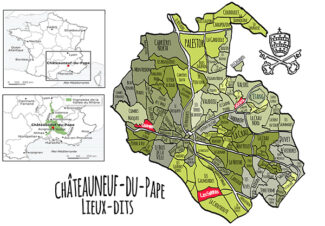
Still, it is Ferrando’s ever-growing expertise and hands-on winemaking that produces her outstanding portfolio. Says ‘The Grenachiste’: “There is no secret formula to making great wines in Châteauneuf. I work with a young team who is always open to new ideas. We rely on tradition without being trapped by it, working with whole-cluster fermentations without added yeasts because we discovered that it increased freshness in the wines and lowered alcohol, giving the wines vibrancy. Aging occurs in a mix of concrete and used foudres for up to 18 months.”
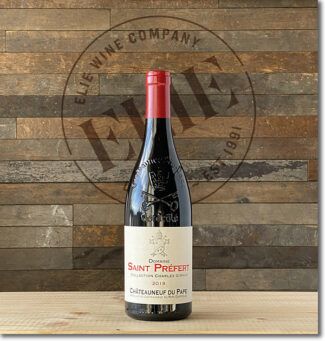 Domaine Saint Préfert ‘Collection Charles Giraud’, 2019 Châteauneuf-du-Pape ($159) (One Bottle)
Domaine Saint Préfert ‘Collection Charles Giraud’, 2019 Châteauneuf-du-Pape ($159) (One Bottle)
60% Grenache, 35% Mourvèdre and 5% Syrah, Isabel Ferrando’s ‘tête de cuvée’ is made from the oldest vines in two parcels—les Serres and le Cristia. The former features the famous, multipurpose galet stones of Châteauneuf that retain heat and night and protect the soil from erosion. Le Cristia is a sandy block with drainage ideal for Mourvèdre’s root system, which does not produce well otherwise. The wine shows concentrated boysenberry and violet pastille and candied fruit and bright, chewy back-end lift. As Auguste Favier was Isabel Ferrando’s maternal grandfather, Charles Giraud was her father’s father.
*click on image for more info
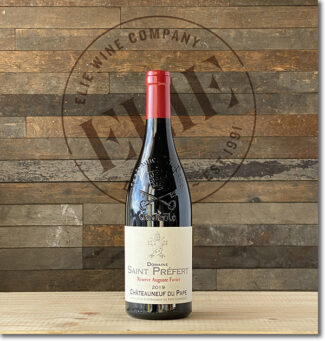 Domaine Saint Préfert ‘Réserve Auguste Favier’, 2019 Châteauneuf-du-Pape ($82) (One Bottle)
Domaine Saint Préfert ‘Réserve Auguste Favier’, 2019 Châteauneuf-du-Pape ($82) (One Bottle)
The label’s eponymous Auguste Favier was Isabel Ferrando’ maternal grandfather; the lieu-dit that produces this blend— 85% Grenache and 15% Cinsault—is also named for an original owner. Les Serres, a vineyard in the southernmost part of Châteauneuf-du-Pape, takes its name from Fernand Serre, who planted it in 1928. The grapes are hand-picked and vinified separately; the Grenache is aged in cement and the Cinsault in 600L barrels. Floral and exotic, the wine expresses a full-bodied core of blackberry draped with a lacy texture, showing rich cassis and raspberry coulis flecked with the garrigue herbs that are native to the area. A long, elegant finish with a surprisingly tannic edge.
*click on image for more info
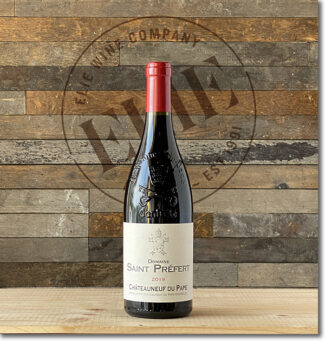 Domaine Saint Préfert ‘Classique’, 2019 Châteauneuf-du-Pape ($53) (One Bottle)
Domaine Saint Préfert ‘Classique’, 2019 Châteauneuf-du-Pape ($53) (One Bottle)
With a base cuvée of 85% Grenache and 5% each of Syrah, Mourvèdre, and Cinsault, aged entirely in concrete tanks, is classic varietal choice as well as in name. Vinified from middle-aged vines—30 years old, tops—this wine is an expression of exuberance crammed with juicy raspberry and bright cherry and light hints of licorice. The sharp subcurrents of smoke and minerality provide a clue that these vines, and the wines they produce, will continue to improve with age.
*click on image for more info
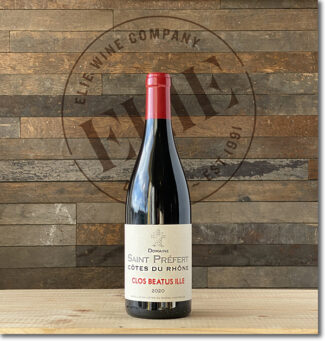 Domaine Saint Préfert “Clos Beatus Ille’, 2020 Côtes-du-Rhône ($30) (One Bottle)
Domaine Saint Préfert “Clos Beatus Ille’, 2020 Côtes-du-Rhône ($30) (One Bottle)
‘Beatus Ille’ is Latin for ‘Happy Man’—it’s a line from Horace’s 2nd Epode and no doubt includes happy women as well. The wine is 85% Grenache blended with about 15% Cinsault from two parcels—La Lionne in the Sorgues district, just at the southern border of Châteauneuf-du-Pape and another parcel in Vedène. It also contains a bit of Syrah from Châteauneuf-du-Pape. A supple and affordable entryway into Isabel Ferrando’s world, the wine shows the traits of the great Crus in Southern Rhône in an approachable package; cassis, plum and fresh red berries with hints of Asian spice and truffles.
*click on image for more info
Available Other Cuvées by Isabel Ferrando
Top: 1. Domaine Préfert (Isabel Ferrando), Châteauneuf-du-Pape ‘Colombis’ 2019, 2. Domaine Saint Préfert, Châteauneuf-du-Pape Blanc 2020, 3. Domaine Préfert (Isabel Ferrando), Châteauneuf-du-Pape ‘F601’ 2018
Bottom: 4. Domaine Saint Préfert, Châteauneuf-du-Pape Blanc 2020 Magnum, 5. Domaine Saint Préfert, Châteauneuf-du-Pape Blanc’Cuvée Spéciale Vieilles Clairettes’ 2019 Magnum
Please, click on image for the rest of her wines
Rhône Vintage Journal
2020
The main features of the year were drought, heat and a very early harvest. Thankfully there were heavy rains in October, November and December 2019 which created reserves for the vines to draw on. There were also welcome rains in May and June that helped sustain the plants. The rest of the year, however, was exceptionally dry. The vineyards roused early thanks to warm weather in March, but mercifully there were no spring frosts here. They held on to this lead throughout the year, resulting in the earliest vintage since 2003.
Northern Rhône: A reliably fresh, balanced and approachable vintage – a return to classicism after a series of powerful years. Excellent white wines.
Southern Rhône: Fresh, juicy and immediate reds with lower alcohol than recent years, though some lack concentration. Beautiful white wines.
2019
Marking the fifth consecutive vintage in which the wines of Northern Rhône can be considered very good or even truly exceptional, 2019 endured an abnormally hot and dry growing season by historical standards (though by current measures, increasingly typical). It began with pockets of spring hail and frost, but nothing so major as to precipitate a short crop. The hot, dry summer that followed definitely induced some angst among the growers, who noted that it was critical to maintain healthy vine canopies to protect the grapes from the heat and sun. Fortunately, for those making such a viticultural move, there was basically no rain during the summer, meaning that mildew that might have formed under the canopies was a non-issue. Also, while it was definitely hot, temperatures were not excessive. Well-timed and beneficial rains in late August and early September helped freshen the vineyards and keep acidity levels sound.
Northern Rhône: A very hot, dry growing season resulting in some rich, opulent reds – sometimes overripe and alcoholic. Côte-Rôtie leads the pack, with Hermitage and Cornas not far behind.
Southern Rhône: A swelteringly hot, very dry year that was surprisingly successful, especially in Châteauneuf-du-Pape, both reds and whites. Elsewhere there are mixed results; some excellent wines, others with unbalanced alcohol or tough tannins.
- - -
Posted on 2022.11.11 in Saint-Joseph, Cornas, Châteauneuf-du-Pape, Côtes-du-Rhône, France, Wine-Aid Packages, Southern Rhone, Northern Rhone
Featured Wines
- Notebook: A’Boudt Town
- Saturday Sips Wines
- Saturday Sips Review Club
- The Champagne Society
- Wine-Aid Packages
Wine Regions
Grape Varieties
Aglianico, Albarino, Albarín Blanco, Albarín Tinto, Albillo, Aleatico, Arbanne, Aubun, Barbarossa, barbera, Beaune, Biancu Gentile, bourboulenc, Cabernet Franc, Cabernet Sauvignon, Caino, Caladoc, Calvi, Carcajolu-Neru, Carignan, Chablis, Chardonnay, Chasselas, Clairette, Corvina, Cot, Counoise, Erbamat, Ferrol, Fiano, Frappato, Friulano, Fromenteau, Fumin, Garnacha, Gewurztraminer, Godello, Graciano, Grenache, Grolleau, Groppello, Juan Garcia, Lambrusco, Loureira, Macabeo, Macabou, Malvasia, Malvasia Nera, Marsanne, Marselan, Marzemino, Melon de Bourgogne, Merlot, Mondeuse, Montanaccia, Montepulciano, Morescola, Morescono, Moscatell, Muscadelle, Muscat, Natural, Nero d'Avola, Parellada, Patrimonio, Petit Meslier, Petit Verdot, Pineau d'Aunis, Pinot Auxerrois, Pinot Blanc, Pinot Gris, Pinot Meunier, Pinot Noir, Poulsard, Prieto Picudo, Rondinella, Rousanne, Roussanne, Sangiovese, Sauvignon Blanc, Savignin, Semillon, Souson, Sparkling, Sumoll, Sylvaner, Syrah, Tannat, Tempranillo, Trebbiano, Trebbiano Valtenesi, Treixadura, Trousseau, Ugni Blanc, vaccarèse, Verdicchio, Vermentino, Viognier, Viura, Xarel-loWines & Events by Date
- April 2024
- March 2024
- February 2024
- January 2024
- December 2023
- November 2023
- October 2023
- September 2023
- August 2023
- July 2023
- June 2023
- May 2023
- April 2023
- March 2023
- February 2023
- January 2023
- December 2022
- November 2022
- October 2022
- September 2022
- August 2022
- July 2022
- June 2022
- May 2022
- April 2022
- March 2022
- February 2022
- January 2022
- December 2021
- November 2021
- October 2021
- September 2021
- August 2021
- July 2021
- June 2021
- May 2021
- April 2021
- March 2021
- February 2021
- January 2021
- December 2020
- November 2020
- October 2020
- September 2020
- August 2020
- July 2020
- June 2020
- May 2020
- April 2020
- March 2020
- February 2020
- January 2020
- December 2019
- November 2019
- October 2019
- September 2019
- August 2019
- July 2019
- June 2019
- May 2019
- April 2019
- March 2019
- February 2019
- January 2019
- December 2018
- November 2018
- October 2018
- September 2018
- August 2018
- July 2018
- June 2018
- May 2018
- April 2018
- March 2018
- February 2018
- January 2018
- December 2017
- November 2017
- October 2017
- September 2017
- August 2017
- July 2017
- June 2017
- May 2017
- April 2017
- March 2017
- February 2017
- January 2017
- December 2016
- November 2016
- October 2016
- September 2016
- August 2016
- July 2016
- June 2016
- May 2016
- April 2016
- March 2016
- February 2016
- January 2016
- December 2015
- November 2015
- October 2015
- September 2015
- August 2015
- July 2015
- June 2015
- May 2015
- April 2015
- March 2015
- February 2015
- January 2015
- December 2014
- November 2014
- October 2014
- September 2014
- August 2014
- July 2014
- June 2014
- April 2014
- March 2014
- February 2014
- January 2014
- December 2013
- November 2013
- October 2013
- September 2013
- August 2013
- July 2013
- June 2013
- May 2013
- April 2013
- March 2013
- February 2013
- January 2013
- December 2012
- November 2012
- October 2012
- February 2004
Search


